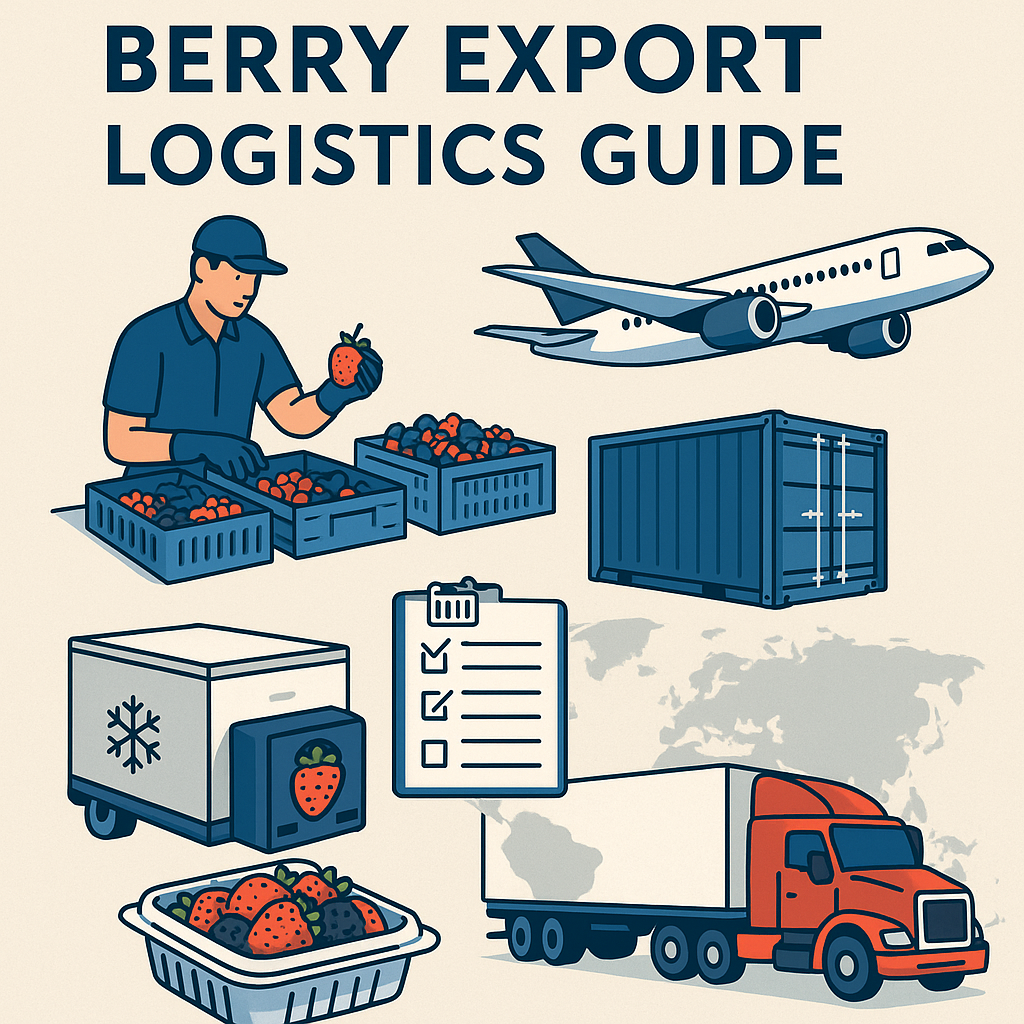Berry Export Logistics Guide: Global Perspective on Efficient Berry Exportation

1. Understanding the Global Berry Market
-
Market Dynamics: Berries are exported worldwide, with major producers including the United States, Mexico, Poland, Spain, Chile, and Turkey. Key importing regions are Europe, North America, and parts of Asia.
-
Consumer Expectations: Freshness, appearance, and nutritional quality are critical for consumer acceptance, making cold chain logistics and speed crucial.
-
Regulatory Requirements: Exporters must comply with phytosanitary regulations, residue limits, packaging, and labeling standards that vary by country.
2. Pre-Export Considerations
a. Harvesting and Post-Harvest Handling
-
Harvest at optimal ripeness to balance shelf life and flavor.
-
Minimize mechanical damage during picking.
-
Immediate cooling (precooling) after harvest, ideally using hydrocooling, forced-air cooling, or vacuum cooling to reduce field heat.
b. Quality Control and Sorting
-
Sort berries by size, color, and ripeness.
-
Remove damaged or moldy fruit to prevent spoilage.
-
Use automated sorting technologies to improve accuracy and speed.
c. Packaging
-
Use breathable, moisture-regulating packaging materials such as vented clamshells or punnets.
-
Incorporate cushioning to reduce mechanical damage.
-
Consider modified atmosphere packaging (MAP) to extend shelf life.
-
Ensure packaging complies with target market regulations (e.g., labeling, traceability).
3. Cold Chain Management
-
Maintain temperature between 0°C and 4°C throughout handling, storage, and transport.
-
Use refrigerated trucks and containers equipped with temperature monitoring systems.
-
Ensure cold storage facilities at packing houses and export terminals are adequately equipped.
4. Transportation Modes and Strategies
a. Air Freight
-
Ideal for premium, highly perishable berries requiring the fastest delivery.
-
Short transit times but high cost.
-
Coordination with airlines for cold storage handling and priority loading.
b. Sea Freight
-
Suitable for frozen berries or processed berry products.
-
Longer transit times but cost-effective for bulk shipments.
-
Requires frozen cold chain capabilities (e.g., reefer containers).
c. Road Transport
-
Commonly used for regional exports or final leg delivery.
-
Must ensure refrigerated vehicles and proper handling protocols.
5. Customs Clearance and Documentation
-
Prepare all necessary export documentation: phytosanitary certificates, certificates of origin, commercial invoices, packing lists, and export permits.
-
Understand import country requirements to avoid delays or rejections.
-
Use experienced customs brokers and freight forwarders specialized in perishable goods.
6. Risk Management
-
Monitor temperature and humidity during transport with data loggers.
-
Implement contingency plans for delays, temperature excursions, or product recalls.
-
Insure shipments adequately against loss or damage.
7. Sustainability and Traceability
-
Incorporate sustainable packaging solutions to reduce environmental impact.
-
Implement traceability systems from farm to consumer to ensure food safety and meet consumer demands.
-
Consider certifications such as GlobalGAP, organic, or Fair Trade to enhance market access.
Conclusion
Exporting berries globally requires a highly coordinated logistics approach focusing on quality preservation, cold chain integrity, regulatory compliance, and efficient transportation. By applying the guidelines outlined in this guide, berry exporters can enhance their competitiveness, reduce losses, and meet the growing global demand for fresh, high-quality berries.
References & Further Reading
-
FAO Technical Guidelines on Fresh Fruit Export Logistics
-
International Plant Protection Convention (IPPC) Standards
-
GlobalGAP Certification Manuals
-
Cold Chain Management Best Practices by the Produce Marketing Association (PMA)
Recent Posts
How to Start Exporting Agricultural Products from Turkey: Step-by-Step Guide
Tarım Ürünlerinde Uluslararası Alıcılar Nasıl Bulunur ve Bağlantı Kurulur?
Berry Export Logistics Guide: Global Perspective on Efficient Berry Exportation
Traverten Mermer Export Guide – Turkish Travertine for Global Buyers
Technical Reasons Behind the Exceptional Quality of Turkish Agria Potatoes for Export
Exporter Zone
ExporterZone – Global Exporters Marketplace for B2B Trade




